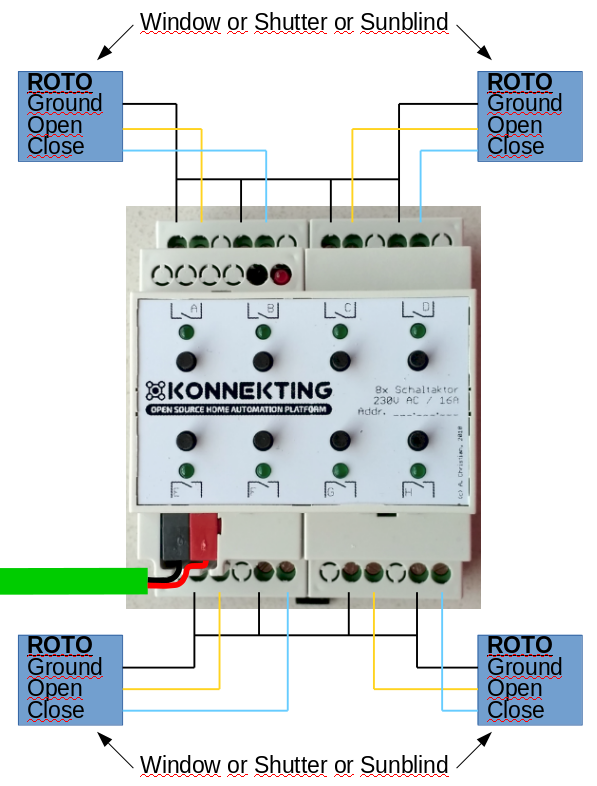DFF4.1 User Manual
This is the user manual for the KONNEKTING DFF4.1 Roto RotoTronic skylight (electrical version https://www.roto-dachfenster.de/produkte/dachfenster/designo-r6-rototronic.html) actuator. Please read it carefully.
Disclaimer
Both the observance of this manual and the application of the construction manual for this kit, as well as the installation, operation, use and maintenance of the resulting device can not be supervised by the DIY kit creator. The DIY kit creator therefore assumes no responsibility and liability for losses, damages or costs resulting from faulty installation and improper operation. So any use of this DIY kit is at your own risk.
Overview
Intended use
This DIY kit is intended to build a device that is used to control a ROTO Rototronic electrical skylight (roof window).
Differentiation to other shutter actuators
A typical shutter actuator is driving the electric engine of the shutter directly. Closing the relay in the shutter delivers the electrical power to the engine. Roto RotoTronic windows and their shutters behave differently: The window has an own control mechanism. To open or close the window or shutter, you need to close a control-contact. Means: You do not deliver the power for the engine through the actuator. The window is already powered separately. You just need to tell the control logic in the window what to do. For Roto RotoTronic this means: Close the "close contact" for >175 milliseconds and the control logik in the window will close the window. And that's the main difference for this actuator: Electrically, the actuator is almost identical to other shutter actuators. What makes this actuor so special, is it's software/firmware, which is able to trigger the control impulses according to what the Roto RotoTronic skylight is expecting.
Supported Devices
The manual refers to the following devices kit constellation:
- Application PCBDFF4.1 rev1.0 and rev1.1
- Controller M0dularisM+ rev1.0 and rev1.1
- Frontend Top8LedButton rev1.0 and rev1.1
Exemplary circuit diagrams
Structure and Handling
The exemplary circuit diagrams shows the structure of the device. Albeit the device obviously has 8 outputs (A..H) and the cover says "8x Schaltaktor", it has - with the intended firmware - only 4 channels.
- channel A+B
- channel C+D
- channel E+F
- channel G+H
Every channel can control either a window, a shutter or the optional sunblind. Every channel has two buttons and two LEDs. Every button and LED is assigned to one output. The first one (f.i. for "channel A+B" this will be A) is for an open-operation and the second one (=B) is for a close-operation. Every channel can be manually controlled by their buttons directly at the device. The LED visualize the current status of move-operation.
For programming the device for the first time and for programming the physical address, the programming button must be pressed. An active programming mode is shown by the red LED next to the programming button.
Functions
TODO
Settings
TODO
Starting up
When the device gets powered, it will bring the configured channels to a default position. For channel type "window", the connected window is closed. For all other types, the connected shutter or sunblind will open.
Communication Objects
TODO
General
TODO
Channel specific
TODO
Parameters
TODO
General
TODO
Channel Specific
TODO
